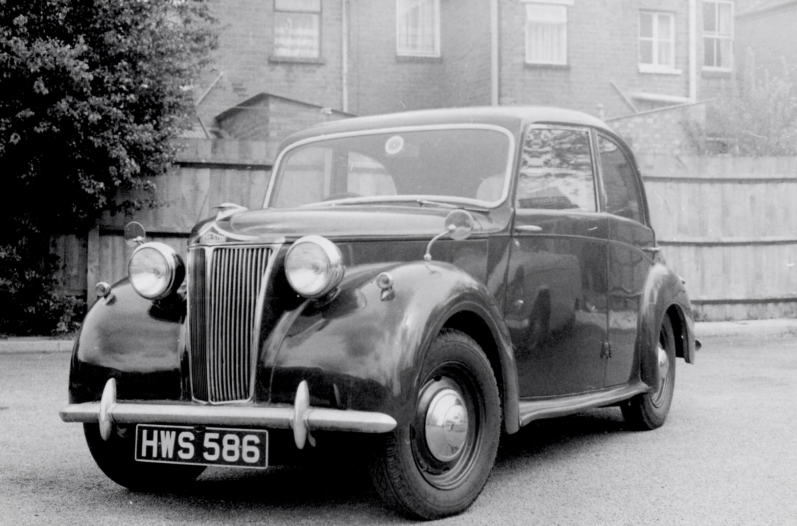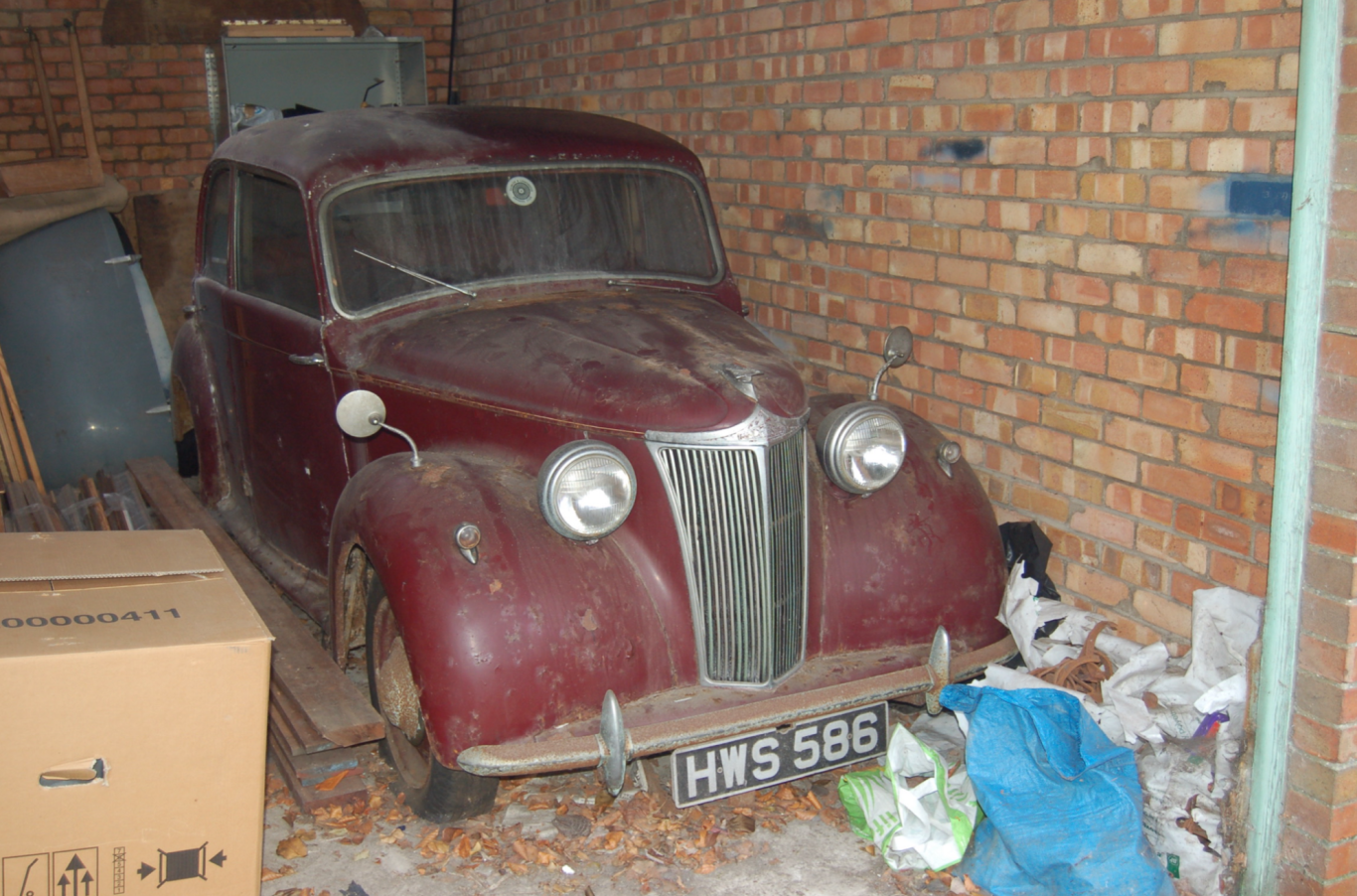
LANCHESTER & ME
Written by Mike Goulding

Having been asked to recount my experiences with Lanchester cars, I reflect here on how, why and when they came into my life.
Being a “Mod” in the late 1960’s, driving a 1959 Austin A35 van which burnt more oil than petrol, I happened to be in “John Temple” tailors being measured for my latest “Pierre Cardin” fashion suit and the manager was chatting away about cars and mentioned his mate who had a Lanchester with a pre-select gearbox, no clutch but a “fluid flywheel”. He went on in infinite detail about the driving technique needed to drive one.
Fast forward to 1970 when me and the “self medicating” drinking gang found ourselves in Scotland, camping in the middle of nowhere drinking responsibly. The following morning must have been a Sunday and finding ourselves in need of sustenance (Bacon and egg sandwich) my mate and me set off to the nearest village (Innerleithen) in a hired A55 Van in which we had slept overnight on our quest. Finding everywhere closed I turned into a side road towards the next village and there she was! In a compound of “Marquis of Midlothian” used cars for sale was my future 1951 Lanchester LD10 Barker bodied maroon saloon HWS 586 sitting next to a 1946 Mk6 Bentley. They were closed.
Returning the next day I negotiated the deal on the basis they put a new MOT on her and I would return the following Saturday holding folding. That left me with a week to sell my Mk3 Triumph Spitfire LOL 584 F with overdrive. I did it!
On the Saturday, I turned up insured and did the deal. Faced with a 300 mile return journey and a full tank of 2* petrol, off I set. Above are photos of how she looked after arriving in Birmingham.
I discovered the joys of classic motoring with this car. It was originally owned by Lord (Jock) Cameron of Edinburgh a Supreme Court Judge and he must have been chauffeured in it because there were signs of a table that had been fitted to the rear of the front seat. I was only the second recorded owner.
Delving into the history of Lanchester cars I discovered they were the first British designed car to be produced beating all the marques expected. Not Daimler, not Austin or any other.
There were 3 Lanchester brothers and George (the engineer and inventor) was responsible for 60/70 patents for his inventions from disc brakes to balancers for 6 cylinder engines which is why he was a consultant to many competitors many of which took financial advantage of him and his inventions. Rolls Royce licence dozens of his improvements.
Manufactured in Montgomery Street Sparkhill Birmingham, the premises still exist as ‘Lanchester House”. The brand featured briefly in Peaky Blinders. Typical for the time, only the chassis was made, the buyer then selected which coach builder to commission the bodies. Lanchester were considered better and more reliable than Rolls Royce and more expensive. Maharajahs used to order multiple chassis for export and have local Indian bodies fitted. The name is still highly respected in India today.
George Lanchester had close connections and a consultancy to Daimler which was part of BSA owned by Lord Docker. In 1931 it is rumoured that BSA pressured their bankers to call in loans made to Lanchester (Bothe BSA & Lanchester shared Lloyds banking) which forced Lanchester into selling out to BSA which removed them as competitors to Daimler. From that date, Lanchesters became effectively small Daimlers until production ceased in 1956.
Sadly, all production moved in 1931 from Montgomery Street to the Daimler factory in Coventry. Machinery and equipment of used was transferred but spare for the original Lanchesters were scrapped ending the proud boast the Lanchesters would supply any part needed for any of their cars however old. This might be the reason why any pre-Daimler Lanchesters are rare, sough after and command high prices when sold.
Realising I had a tremendous responsibility to protect and cherish my LD10, I started to restore issues I found on using it as my daily driver. The first issue was to look at the carburettor which as far as I knew needed cleaning and adjusting. Research on “Zenith” carbs led me to a local restorer in Floodgate Street Birmingham who took the car in, cleaned, rejetted and tuned the carb at the cost of a limb!
I then had to hobble to get a vibration from the engine solved. Being part of the Daimler group, I approached the local Daimler dealer (now long gone). Checking on progress a day or so later I was told the engine mount had collapsed with time and there were no replacements. However, the apprentices had been swarming over the car with great interest and 1 had devised a way of welding a patch with a rubber insert to do the best I could. Parting with another limb, I wheeled away rejoicing the result.
Next would be resolution of poor braking. Rod brakes. Girling were based at West Bromwich and I called them about the problem. The call lasted ages as soon as I mentioned the car it became the centre of attention. They agreed to look at it ad we booked it in. The following day I called and it was still being looked at including the apprentices swarming all over it like a rash. The following day I was called by a Director of Girling and grilled over its history and everything about it. He had never seen one. He said there were no spares, the “bell castings were worn, causing loss of braking”. He offered to put the apprentices on it and get parts remanufactured. It would take a couple of weeks. I couldn’t leave it that long as it was my transport to work so agreed to pick it up as I would have to pay for the parts and Girling would pay the labour. In fairness, the guy was great and offered to change the brake shoes FOC which I snatched his leg off for.
I used this car every day and relished the attention it got at traffic lights, car parks, police stops ( for curiosity). I attended a Club Meeting at Ragley Hall and whilst rambling around the range of other Lanchesters heard an announcement asking for the owner of HWS 586 to return to his car. Fearing the worst I rushed back. On arrival, I was presented with an award for having the “Best Daily Driver” from the “Daimler and Lanchester Owners Club”.
Fast forward to 1978. The need to leave the nest started off my saving pot to garner a deposit for my own flat. The arrival of a new job with company car (Vauxhall Viva VVT 986 L) and a leaking garage roof etc. You get the picture. A fellow Club member with several Daimler and Lanchesters was interested and so the decision was made reluctantly. I kept in touch with the fellow member and managed to get to see him a couple of years ago in Scarborough. He was reluctant to let me have a reunion with HWS586 as it was in a lockup on the other side of town. Hw gladly showed me his garage with the only surviving prototype LD10 from 1939. He had an early Daimler he used for the Brighton run and other interesting Lanchesters. Pestering and pestering him, he eventually agreed to let me see HWS 586 again. On arrival at the lock up, I wasn’t impressed by a large sapling growing across the garage door. After cutting it away it revealed a sight which struck me to the core. There it was, the most cherished car I ever owned, languishing in a leaking garage, wood stacked on and around it. Flat tyres, rust patches the size of my hand, mouldy leather, stained headlining. Heartbreaking
The story continues: I was offered it back for £1500 “It just needs a battery”. I declined on the basis that it needs a body off rebuild. The chassis I would have acid dipped and powder coated. The engine, pre-select and fluid flywheel totally rebuilt. New West Country Cloth headlining. Rewire. Upgrade to electronic ignition for reliability. Investigate hydraulic braking or totally rebuild and remanufacture the rod brakes. Investigate swapping dynamo for alternator. Fit appropriate period indicator lights as no one knows what traffickers are today. All interior wood needs finishing, retire where required with period leather. Full quality respray to highest standard in original colour. Let’s say around £10k plus?
Since my visit to Scarborough, sadly my friend has died. My understanding is that his collection has gone to auction and HWS 586 has changed ownership. I sincerely hope that whoever has ownership gives it the care and attention it deserves and it lives on for future enthusiasts.
My story is unusual in that it follows a car in daily use in beautiful condition, sold because it was in a leaky garage, to a barn find in a leaky garage in need of care and attention.
Having been asked to recount my experiences with Lanchester cars, I reflect here on how, why, and when they came into my life.
Being a “Mod” in the late 1960s, driving a 1959 Austin A35 van which burnt more oil than petrol, I happened to be in “John Temple” tailors being measured for my latest “Pierre Cardin” fashion suit, and the manager was chatting away about cars and mentioned his mate who had a Lanchester with a pre-select gearbox, no clutch, but a “fluid flywheel”. He went on in infinite detail about the driving technique needed to drive one.
Last forward to 1970 when my friend and I, the “self-medicating” drinking gang, found ourselves in Scotland, camping in the middle of nowhere, drinking responsibly. The following morning must have been a Sunday, and finding ourselves in need of sustenance (a bacon and egg sandwich), my mate and I set off to the nearest village (Innerleithen) in a hired A55 van in which we had slept overnight on our quest. Finding everywhere closed, I turned into a side road towards the next village, and there she was! In a compound of “Marquis of Midlothian” used cars for sale was my future 1951 Lanchester LD10 Barker-bodied maroon saloon HWS 586 sitting next to a 1946 Mk6 Bentley. They were closed.
Returning the next day, I negotiated the deal on the basis that they put a new MOT on her, and I would return the following Saturday holding folding. That left me with a week to sell my Mk3 Triumph Spitfire LOL 584 F with overdrive. I did it.
On Saturday, I turned up insured and did the deal. Faced with a 300-mile return journey and a full tank of 2* petrol off, I set off. Below are photos of how she looked after arriving in Birmingham.
I discovered the joys of classic motoring with this car. It was originally owned by Lord (Jock) Cameron of Edinburgh, a Supreme Court Judge, and he must have been chauffeured in it because there were signs of a table that had been fitted to the rear of the front seat. I was only the second recorded owner.
Delving into the history of Lanchester cars, I discovered they were the first British-designed car to be produced, beating all the marques expected. Not Daimler, not Austin, or any other. The first— end of.
There were 3 Lanchester brothers, and George (the engineer and inventor) was responsible for 60/70 patents for his inventions, from disc brakes to balancers for 6-cylinder engines, which is why he was a consultant to many competitors, many of which took financial advantage of him and his inventions. Rolls-Royce licensed dozens of his improvements.
Manufactured in Montgomery Street, Sparkhill, Birmingham, the premises still exist as ‘Lanchester House”. The brand featured briefly in Peaky Blinders. Typical for the time, only the chassis was made; the buyer then selected which coach builder to commission the bodies. Lanchester was considered better and more reliable than Rolls-Royce and more expensive. Maharajahs used to order multiple chassis for export and have local Indian bodies fitted. The name is still highly respected in India today.
George Lanchester had close connections and a consultancy to Daimler, which was part of BSA owned by Lord Docker. In 1931, it is rumoured that BSA pressured their bankers to call in loans made to Lanchester (both BSA & Lanchester shared Lloyds banking), which forced Lanchester into selling out to BSA, which removed them as competitors to Daimler. From that date, Lanchesters became effectively small Daimlers until production ceased in 1956.
Sadly, all production moved in 1931 from Montgomery Street to the Daimler factory in Coventry. Machinery and equipment of use was transferred but spare for the original Lanchesters were scrapped ending the proud boast the Lanchesters would supply any part needed for any of their cars however old. This might be the reason why any pre-Daimler Lanchesters are rare, sought after and command high prices when sold.
Realising I had a tremendous responsibility to protect and cherish my LD10, I started to restore issues I found on using it as my daily driver. The first issue was to look at the carburettor, which, as far as I knew, needed cleaning and adjusting. Research on “Zenith” carbs led me to a local restorer in Floodgate Street, Birmingham, who took the car in, cleaned, rejetted, and tuned the carb at the cost of a limb!
I then had to hobble to get a vibration from the engine solved. Being part of the Daimler group, I approached the local Daimler dealer (now long gone). Checking on progress a day or so later, I was told the engine mount had collapsed with time, and there were no replacements. However, the apprentices had been swarming over the car with great interest, and 1 had devised a way of welding a patch with a rubber insert to do the best I could. Parting with another limb, I wheeled away rejoicing at the result.
Next would be resolution of poor braking. Rod brakes. Girling were based at West Bromwich, and I called them about the problem. The call lasted ages as soon as I mentioned the car, it became the centre of attention. They agreed to look at it ad we booked it in. The following day, I called, and it was still being looked at, including the apprentices swarming all over it like a rash. The following day, I was called by a Director of Girling and grilled over its history and everything about it. He had never seen one. He said there were no spares, the “bell castings were worn, causing loss of braking”. He offered to put the apprentices on it and get parts remanufactured. It would take a couple of weeks. I couldn’t leave it that long as it was my transport to work, so I agreed to pick it up as I would have to pay for the parts, and Girling would pay the labour. In fairness, the guy was great and offered to change the brake shoes FOC, which I snatched his leg off for.
I used this car every day and relished the attention it got at traffic lights, car parks, police stops ( for curiosity). I attended a Club Meeting at Ragley Hall and whilst rambling around the range of other Lanchesters, heard an announcement asking for the owner of HWS 586 to return to his car. Fearing the worst, I rushed back. On arrival, I was presented with an award for having the “Best Daily Driver” from the “Daimler and Lanchester Owners Club”.
Fast forward to 1978. The need to leave the nest started off my saving pot to garner a deposit for my own flat. The arrival of a new job with a company car (Vauxhall Viva VVT 986 L) and a leaking garage roof etc. You get the picture. A fellow Club member with several Daimler and Lanchesters was interested, and so the decision was made reluctantly.
I kept in touch with the fellow member and managed to get to see him a couple of years ago in Scarborough. He was reluctant to let me have a reunion with HWS 586 as it was in a lockup on the other side of town. Hw gladly showed me his garage with the only surviving prototype LD10 from 1939. He had an early Daimler he used for the Brighton run and other interesting Lanchesters. Pestering and pestering him, he eventually agreed to let me see HWS 586 again. On arrival at the lockup, I wasn’t impressed by a large sapling growing across the garage door. After cutting it away, it revealed a sight which struck me to the core. There it was, the most cherished car I ever owned, languishing in a leaking garage, wood stacked on and around it. Flat tyres, rust patches the size of my hand, mouldy leather, stained headlining. Heartbreaking.
The story continues: I was offered it back for £1500. “It just needs a battery”. I declined on the basis that it needs a body rebuild. The chassis I would have acid-dipped and powder-coated. The engine, pre-select and fluid flywheel totally rebuilt. New West Country Cloth headlining. Rewire. Upgrade to electronic ignition for reliability. Investigate hydraulic braking or totally rebuild and remanufacture the rod brakes. Investigate swapping dynamo for alternator. Fit appropriate period indicator lights as no one knows what traffickers are today. All interior wood needs finishing, retire where required with period leather. Full-quality respray to highest standard in original colour. Let’s say around £10k plus?
Since my visit to Scarborough, sadly my friend has died. My understanding is that his collection has gone to auction and HWS 586 has changed ownership. I sincerely hope that whoever has ownership gives it the care and attention it deserves and it lives on for future enthusiasts.
My story is unusual in that it follows a car in daily use in beautiful condition, sold because it was in a leaky garage, to a barn find in a leaky garage in need of care and attention.




We need your consent to load the translations
We use a third-party service to translate the website content that may collect data about your activity. Please review the details in the privacy policy and accept the service to view the translations.

